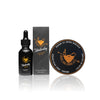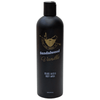Sometimes, beard sores and beard itch can be a sign that your beard is growing, especially if you're in the early stages of growing facial hair. However, sometimes it can be a sign of skin conditions that may require medical treatment.
Don't worry - in this article we're going to walk through the most common causes of sores under your beard, to help you work out what's causing it, why you got it in the first place, and how you can treat it.
Disclaimer: we're not doctors, we're dudes with beards. If in doubt, always consult a medical professional.
Beard Sores and Itch Causes: Beard sores and itch can be due to conditions like pseudofolliculitis barbae, folliculitis barbae, or tinea barbae, which may need medical treatment.
Pseudofolliculitis Barbae: Commonly known as razor bumps, it's caused by ingrown hairs and usually resolves without treatment, though beard care can help.
Beard Itch from Growth: Beard itch, especially in early growth stages, is often due to insufficient natural oils; using beard oil can help soothe irritation and hydrate skin.
Beard Care Tips: For a healthy beard, regularly clean with beard shampoo, use beard oil to prevent dryness, and exfoliate with a beard brush to clear dead skin cells.
Table of Contents
3 common causes of beard sores and rashes

1. Pseudofolliculitis Barbae
What is it, and what causes it?
Known commonly as 'razor bumps', pseudofolliculitis barbae occurs when sharp, new beard hairs cut the skin inside the follicle as they're trying to grow out, or curl back on themselves and start to grow back into your skin. These ingrown hairs cause inflammation and can even result in blisters that fill up with pus.
Pseudofolliculitis and ingrown hairs are much more common in guys who regularly shave with a manual razor as opposed to an electric one. Guys with curly beard hair are particularly prone to folliculitis barbae, as are black men and overweight individuals.
What's the cure?
As the name "pseudo" folliculitis suggests, although it may look like an infection, it isn't caused by any kind of bacterial infection. Usually, it'll go away on its own without the need for treatment, but if it persists, you could consider:
Washing your face and facial hair before shaving
Moisturising after shaving
Cleaning your beard with a quality beard shampoo
Using a beard oil or balm to soften new beard hairs
As always, if symptoms persist, speak with your doctor or a licensed dermatologist. If it gets worse, pseudofolliculitis can develop into an infection.

2. Folliculitis barbae
What is it, and what causes it?
Notice this one doesn't have "pseudo" in the name.
When your beard hair follicles get inflamed, you can end up with folliculitis. Unlike pseudofolliculitis barbae, folliculitis barbae can be brought on by a parasite, bacterial, viral or fungal infection.
Like pseudofolliculitis, folliculitis is caused by shaving against the grain, not properly washing your beard (especially after exercising, or if you have a physical job), and not changing your razor regularly.
What's the cure?
Folliculitis barbae will usually go away on its own. However, in severe cases, your doctor might prescribe antifungal cream or antibiotics, or antihistamines or NSAID medications to help with itching and inflammation.
3. Tinea Barbae
What is it, and what causes it?
Tinea barbae is a fungal infection of the skin, characterised by inflammation and redness. It affects the area surrounding the beard, which can also fill with pus.
What's the cure?
This one isn't worth waiting around on. Fungal infections aren't likely to settle by themselves, so if you suspect you have tinea barbae, book an appointment with your doctor or dermatologist, or consult with a local pharmacist to find out the best treatment for you. This will usually be a course of antifungal medicine (either topical or in pill form).
Infection, or a sign of beard growth?
No signs of infection, but still afflicted by an annoying, itchy beard?
Fret not, fellow beardsman - there could be an easy explanation here.
1. Beard itch on younger, shorter beards
Almost everyone experiences beard itch and irritated skin when they get old enough to first start growing a beard.
Succumb to that itch too often, and you'll eventually create cracked, dry skin which can be uncomfortable to the touch. This isn't caused by a bacterial or fungal infection, but damn can it feel like one.

Want to learn more about the stages of beard growth? Find out how old you need to be to grow a full beard in our latest guide here.
How to relieve beard itch
Your beard hairs are naturally nourished by a type of oil your skin produces, called sebum, which comes from the sebaceous glands. When your beard is short, there's enough of this stuff to go around.
But as it gets longer, sebum comes in short supply. And when that happens, you'll get itchy and dry skin, eventually creating what can look and feel like a flaky rash.
Itchy, dry skin isn't nice. Many bearded guys take this as a sign that beard growth isn't for them, when in fact all they need to do is start a beard care routine.
Enter beard oil - the saviour of itchy beards worldwide
High-quality, all-natural beard oil is as close as you'll get to natural sebum oil. Ruling out any underlying skin conditions, beard oil will banish beard itch and hydrate dry skin in a matter of days.
All you need to do is:
Find a beard oil online (more on that below)
Apply a few drops to your palms
Rub them together
Distribute evenly through your beard and skin underneath
Repeat morning and night
Do this, and you'll notice your beard itch, dry skin and beard dandruff disappear within a few days. Many men report relief from skin irritation almost immediately, as the natural oils soothe irritated skin and reduce hair follicle inflammation.

Our beard oil recommendation - Honest Amish
Hand-crafted in the USA and made with all-natural and organic ingredients, there's a reason Honest Amish is 'the most trusted brand for beards in the world'.
Packed with jojoba, argan and 6 more premium hydrating oils, Honest Amish beard oil contains everything you need to nourish your facial hair, cure your itchy beard and prevent beard rash caused by dry skin.
2. Beard itch on older, longer beards
Had a beard for a while, and only just starting to experience the dreaded beard itch? Again, if you've ruled out an underlying skin condition, there could be an explanation other than infection.
Longer beards are harder to care for. If you don't look after them properly, dead skin cells can build up and embed themselves in your facial hair, causing your pores to get blocked. If you're using beard oil and aren't washing your beard regularly, this can build up too.
Enter the beard brush and shampoo - exfoliator and cleanser of beards and facial skin
By using a beard brush and shampoo, you'll target those otherwise hard-to-reach places, keeping your beard hair clean and fresh. You'll also keep your pores clear from dead skin cells, excess beard oil, and other day-to-day debris.
How to use your beard brush and shampoo combo:
Pre-shower, brush your beard to exfoliate the skin underneath
Mid-shower, apply your beard shampoo and rub into a lather
Wash out your shampoo
Post-shower, dry your beard, apply beard oil, and brush it through to evenly distribute it
Our beard brush recommendation - Zilberhaar
These guys have been around for as long as we can remember, and they've stood the test of time. I bought this beard brush before we started making our own, and through regular cleaning and care, it's still around and in good condition.
The Zilberhaar beard brush is perfect for guys with medium to long beards, as the bristles are reasonably tough. This helps you to easily target the skin underneath your beard and exfoliate that beard dandruff, without causing further irritation.
Our beard shampoo recommendation - Zeus
From cheap to luxurious, we've used a bunch of different beard shampoos, and Zeus comes out on top. It's a little on the premium side, but it's one of the few shampoos we've tried that doesn't completely dry out your beard. After using Zeus beard shampoo, your beard will be left soft and clean.


